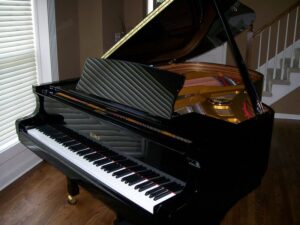 As a piano tuner in Massillon and Canton Ohio, I see lots of pianos. Good ones and bad ones. And if you look on internet classified ads, you will always see pianos listed for sale. Many of them will be free. Some are garbage but others are good, quality pianos.
As a piano tuner in Massillon and Canton Ohio, I see lots of pianos. Good ones and bad ones. And if you look on internet classified ads, you will always see pianos listed for sale. Many of them will be free. Some are garbage but others are good, quality pianos.
But here’s what I see happening a lot; the average person looking to buy or sell a piano likely doesn’t know how to tell the difference between a junk piano and a good piano. When they look at a website such as Facebook Marketplace, at any given time there might be 5 to 10 free pianos along with a few that are listed for between $100 to $500. So, it gives the impression that pianos are practically worthless and most of them you can’t even give away.
But let me tell you about what happened recently. I had a customer call me and say she received a free piano and wanted it tuned. I drove to her house and was surprised when I walked in and looked at the piano. It was about 7 years old and was one of the top brands of pianos in the world. I asked how she got it for free and she said the previous owner thought no one wants pianos anymore, so he just gave it to her for free. Imagine the look on her face when I told her that the piano she just got for free was worth $5,000.
If you have a piano you want to get rid of, how do you decide how much it’s worth?
Here are four questions to answer when selling a used piano:
1. What brand name is the piano?
Before radio was invented, nearly everyone in America had a piano. As such, there were hundreds of piano manufactures. Names like Everett, Winter, Gulbransen, Lester and Lowery are just a few of the many piano manufacturers that went out of business long, long ago but these old pianos are still around and are typically not worth much.
However, names like Steinway, Kawai, Yamaha, Baldwin and Bösendorfer represent quality pianos that are still made today. So it’s very important to call out in your advertisement what brand of piano you’re selling. Don’t do what most people do when they write simply “Piano for sale”.
2. What type of piano is it? A spinet or a console? A baby grand or a 6-foot grand?
Many people call all upright pianos a spinet. But spinet pianos were designed from the beginning to be a cheap piano. So if you have a studio, console or full upright piano, and you list it for sale as a spinet piano, you’re doing yourself a disservice.
Likewise, many people will call almost every grand piano a baby grand but any grand piano that’s 6 feet long or more is definitely not a baby grand.
3. How old is the piano?
My experience as a piano tuner is that when pianos get past about 50 years in age, they typically start having problems related to their age. Hammers start getting hard and slow, leather parts start to deteriorate, strings start to rust, etc….This is especially true for pianos that are 80, 90 or even more than 100 years old. I see pianos like this all the time.
But pianos that are less than 30 years old are almost always in perfect condition and will still have decades of life left in them. A piano’s age can often be determined by its serial number. The serial number is most often written on the piano plate inside the piano.
4. What is the piano’s current condition?
As stated above, piano with rusty strings and worn out parts won’t be worth nearly as much as one that’s in good condition. But there’s also the condition of the exterior to consider. People can ruin the outside of a piano by putting a cold drink on the wood, or a vase of flowers on top of the piano. If the outside of the piano has scratches, dents and water stains, it’s not going to be worth as much as one that still looks new.
And when you list your piano for sale, do the following:
• Take everything off of the piano. Yes, this is work and seems like a pain, but an advertisement featuring a piano covered in knickknacks and family photos, will not readily sell.
• Dust the piano.
• Lift the key cover before taking any photos. Let people see the keys.
• Don’t take towering photos. Get down on your knees or sit on a chair so that the camera is level with the piano.
• Photograph the brand name on the underside of the key cover.
• Lift the lid and photograph the inside of the piano
• Photograph any damage like large scratches or water marks.
Photo credit: flickr Creative Commons, Petrof Grand Piano by Daryl Durand
